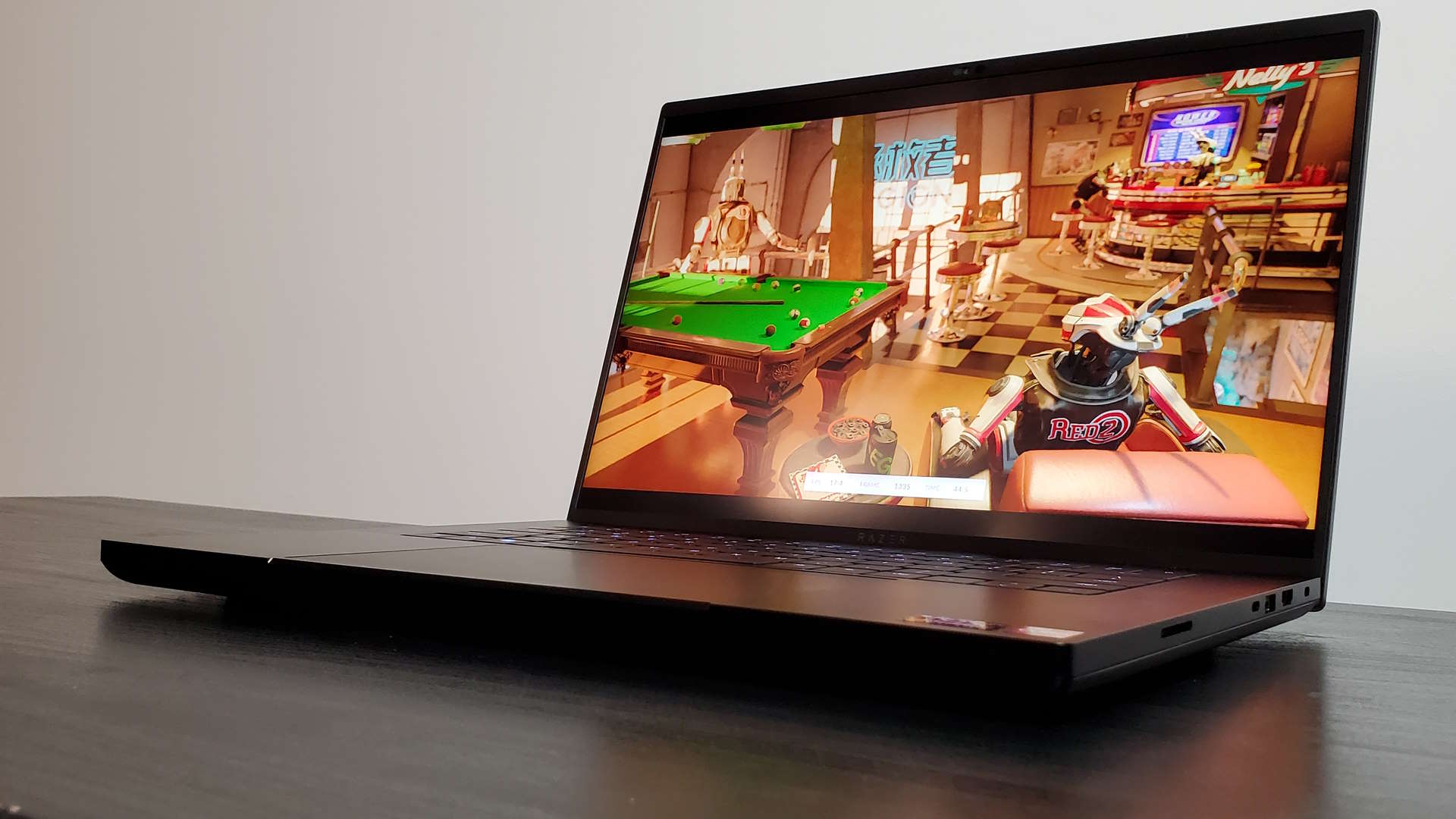Our Verdict
This top Blade 16 spec delivers outstanding performance, in both gaming and productivity terms, and retains the classic Blade styling. It also comes with the best laptop screen I've ever used. But inconsistencies in the experience, and a punitive price tag makes it difficult to recommend.
For
- Desktop RTX 3090 frame rates
- Desktop CPU performance
- Sleek chassis
- Stunning screen
Against
- Prohibitively priced
- Gets hot and loud
- Dual-mode screen feature a non-starter
PC Gamer's got your back
When CES delivered our first taste of this new generation of gaming laptops the Razer Blade 16 was instantly the one I wanted. Now I've got it in hand, this slightly chonkier Blade notebook is delivering previously unseen levels of productivity and gaming performance in a mobile platform, displays some impressive technical chops, and I'm a little bit in love with it. Though only a little bit.
I'm getting gaming frame rates that are on par with a desktop RTX 3090 graphics card, but with near 70% decrease in power consumption. That's pretty astounding, and means you're actually going to be able to properly drive the gorgeous new 4K screens the latest gaming laptops have to offer.
With RTX 3090 power in a laptop, what's not to like? As it turns out, actually quite a lot.
For one thing there's the price. You thought graphics card pricing had gotten out of control, just look at what it's done to laptops. I've not seen a single RTX 4090-toting notebook retailing for under four grand. Indeed, the MSI Titan GT77 I've looked at is well over the five grand mark.
Look at that price tag, mortal, and know fear.
Frankly, the sky-high pricing permeating every single facet of PC gaming is starting to utterly devalue the technical achievements which would otherwise be front and centre in a next-gen review such as this. I want to just talk about topping 60 fps in pretty much any game you could throw at it while running at top 4K settings; to talk about how astounding it is that we're getting genuine workstation-like performance from something that looks like a MacBook from the dark side.
Instead, look at that price tag, mortal, and know fear. I understand Razer machines often demand a premium, but this isn't a situation singular to its next-gen laptops. Asus' Zephyrus M16, which I've also been testing alongside the Blade 16, has a lower system spec but is still $4,000. And yeah, that MSI…
Then there's the practicality of jamming this sort of high-performance hardware into a mobile machine. What I will say is that if you're intent on buying an RTX 4090 gaming laptop, with the latest generation of Intel processor inside it, then you're also going to want to make sure you've got the best noise-cancelling headphones on the market.
They're hella loud, I guess is what I'm trying to say.
Razer Blade 16 specs
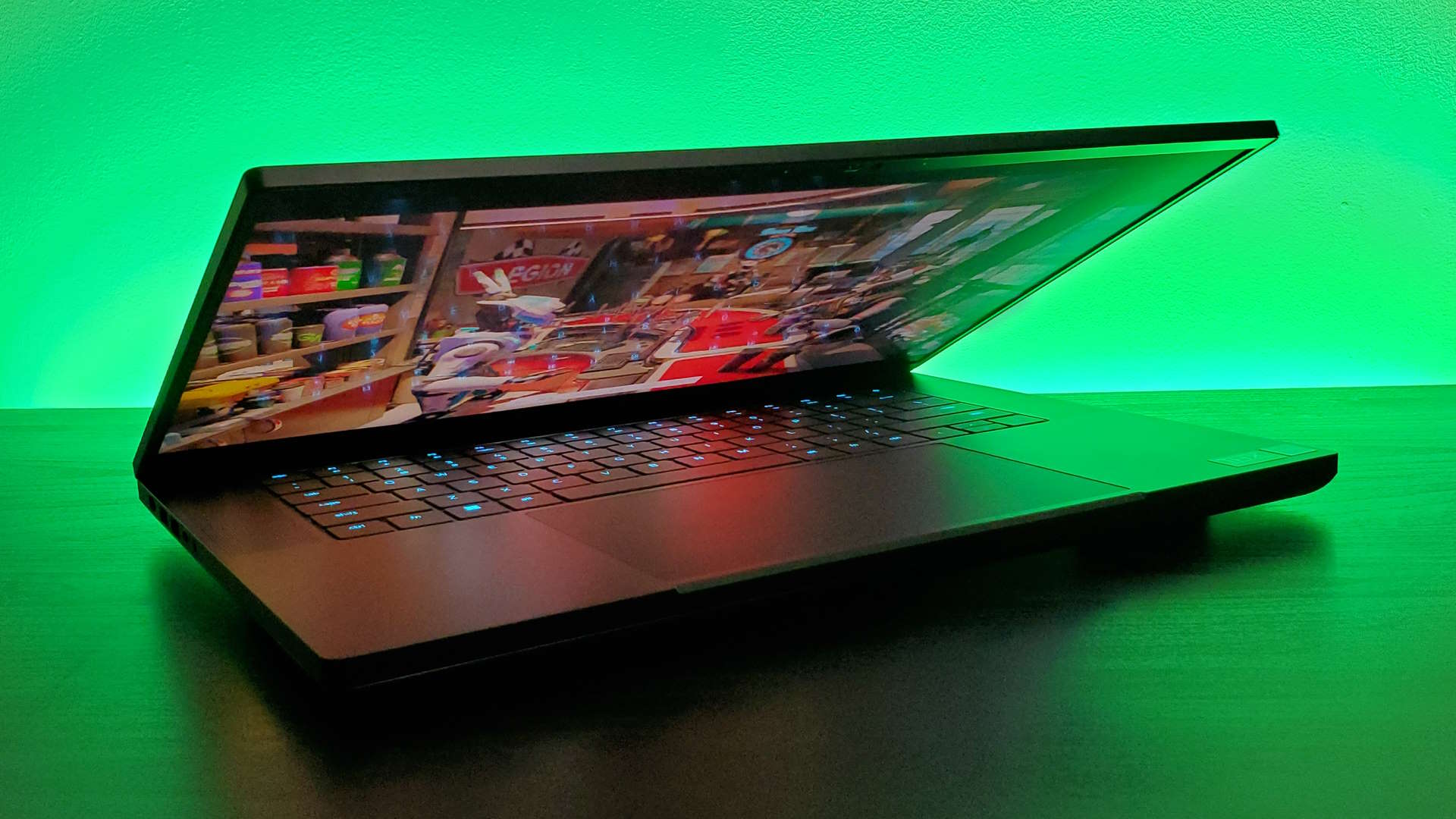
There is a whole suite of new Blade 16 gaming laptops, and they're likely to end up entirely replacing the existing Blade 15 lineup. That's been the stalwart system from Razer's laptop lineup for what seems like a millenia, but its time is up. I believe there is going to be a range of Blade 15s with RTX 40-series innards, but I'd be surprised to see new versions coming around in the next refresh.
That's mostly because the Blade 16 is effectively the same size as the 15-inch machine. There are a few millimetres here and there, but otherwise it's the same footprint. Razer has pretty much done away with the bezel around the screen, which has enabled it to squeeze a full 16-inch 16:10 panel into the space the old 15-inch 16:9 displays would sit.
And that makes it soooo much better. I'll come back to purr about the screen some more, but suffice to say for now I've never felt this way about a laptop panel before.
The GPU
The key spec in this review machine is the RTX 4090 nestled inside that still surprisingly slight Blade chassis. It's the top 175W GPU behemoth, too. While Nvidia lists the TGP range as between 80 and 150W, there is still a 25W leeway allowed to manufacturers who wish to go all out with the GPU power draw.
It is not, however, a 'true' RTX 4090 in the desktop sense of the name. Nvidia, once more, is using its nomenclature for the mobile GPUs to denote a hardware stack rather than to conform to their relative desktop silicon. It's about lining up with the experience, Nvidia tells me, to which I counter that is also what lead to the whole RTX 4080 12GB unlaunching debacle.
It was the same with the RTX 30-series, however, so it's no real surprise the RTX 4090 GPU inside the Blade 16 is actually the same chip as inside the desktop RTX 4080. The exact same. Cores, cache, memory, the lot. It's just down-clocked by a full 1GHz so it's not chugging down power at the same rate as its desk-bound brethren.
That still makes it an absolute monster of a mobile GPU, so maybe Nvidia's offset lineup doesn't seem quite so disingenuous as it might at first glance.


The RTX 4090 sports the full Ada Lovelace package, which might sound a little Only Fans, but basically means you're getting all the power efficiency of Nvidia's latest 4nm GPU architecture and a good bit of the performance to boot. That means it's not a million miles away from the Ampere architecture in actual core design, but comes with higher clock speeds than the previous generation and a huge uptick in L2 cache memory. And that really makes the difference when it comes to gaming.
But it also means you get the glorious goodness of DLSS 3 and Frame Generation. This is what makes it possible to run the most demanding games at 4K on ultra ray-traced settings and still come out with a playable frame rate.
And, personally, I think Frame Generation is going to be one of the biggest things to happen to subsequent mainstream gaming laptops in years. If you're sticking to a 1080p screen you're arguably not going to want to use upscaling when you're then basing it on such a low input resolution, but Frame Generation will still give you that smoother performance without any hit on the visual fidelity of a game.
For the RTX 4060 and RTX 4050 laptops, that alone could be a game-changer. Though I'm still not entirely convinced about their actual core configurations.
The CPU
The other side of this workstation-in-disguise setup is the processor, and the Intel Core i9 13950HX is another silicon monster. Using the latest Raptor Lake core architecture you're getting the full hybrid experience with eight Performance-cores and 16 Efficient-cores delivering a total of 24 cores and 32 threads of raw processing grunt.
And its promised 5GHz+ clock speeds aren't just cosmetic, either: you will actually see the CPU hit 5.3GHz even in the Blade 16's relatively slight chassis. Though we are talking about a modern Intel chip architecture that is heavy on the power and aggressively toasty on the thermals.
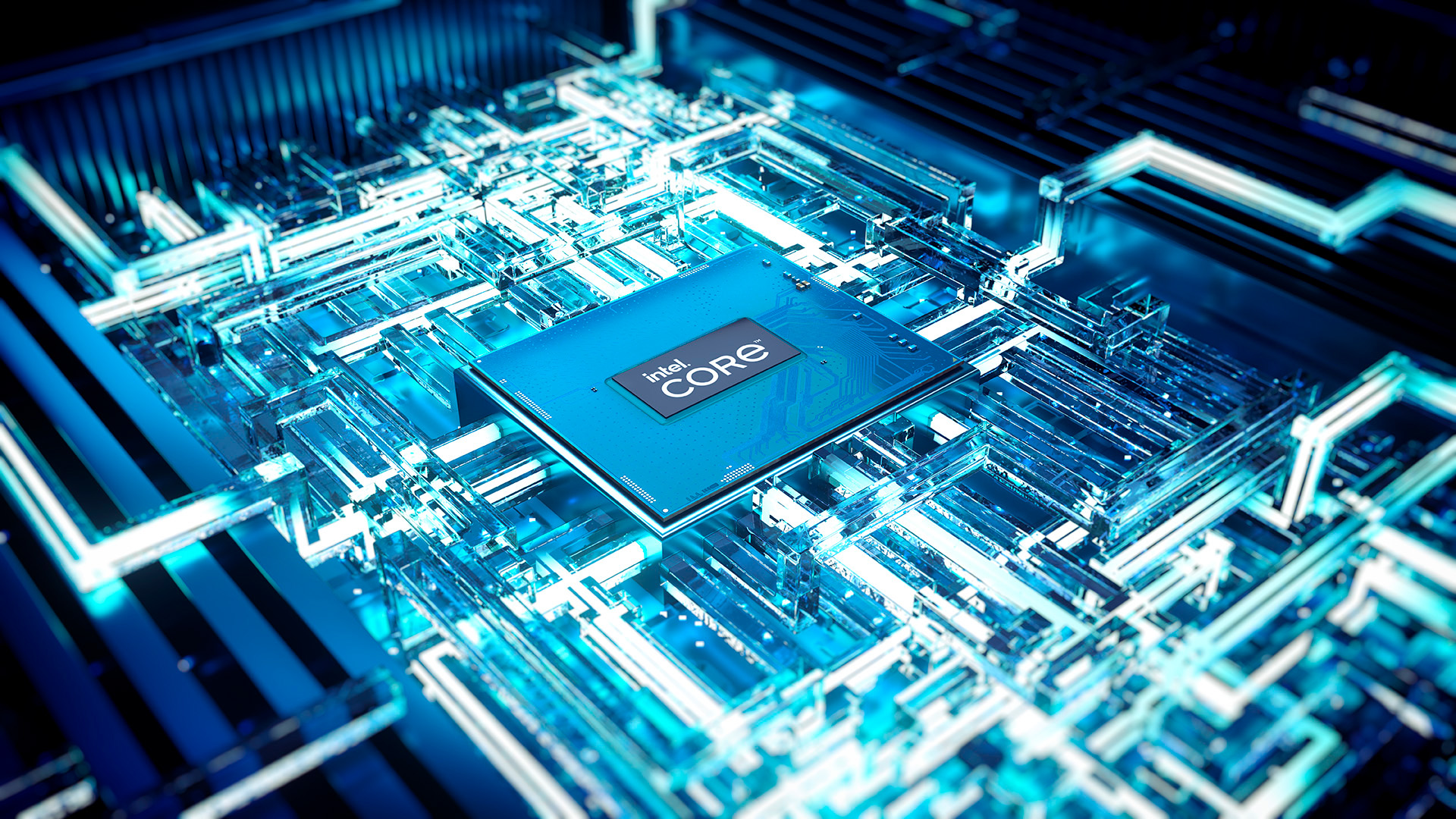
For all the power and splendour of the Nvidia GPU, it's the Intel CPU which is more taxing on the Blade's vapour chamber cooling. And when the processor's spooled up that is what's going to give you the Harrier jump jet take-off acoustics I've grown to loathe when gaming on this machine.
RAM and storage
To back up the core spec, with this top-end Blade 16, you get 2TB of NVMe storage (expandable to 4TB with an open x2 slot available for upgrades) and 32GB of DDR5-5600 (expandable to 64GB). Of the five different Blade 16 SKUs Razer has to offer, the RTX 4060 and RTX 4070 versions still ship with a 1TB SSD and 16GB DDR5-5600, so the spec is relatively high across the board.
As is the price. Always back to the price. The lowest spec Blade 16, with the RTX 4060, still comes in at $2,700, and we don't yet know how that lower class of Ada GPU is actually going to perform. At just 3,072 CUDA cores, the RTX 4060 is significantly below the expected spec of the desktop RTX 4060 (rumoured to be a 4,608 core chip, the same as the mobile RTX 4070). With the desktop RTX 4060 suggested to perform around the same level as an RTX 3070 Ti, the lower-caste mobile version might just perform… like an RTX 3060?
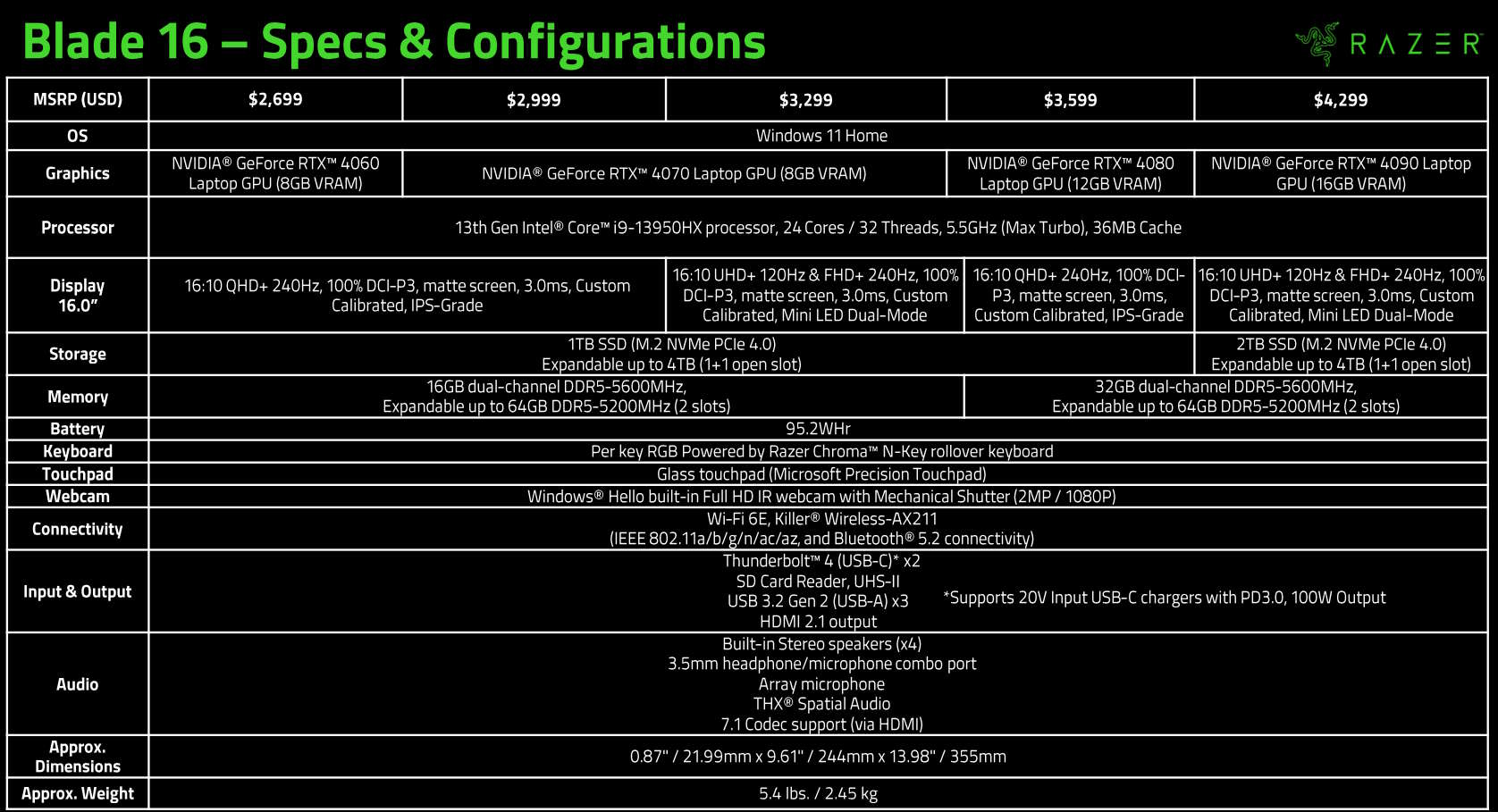
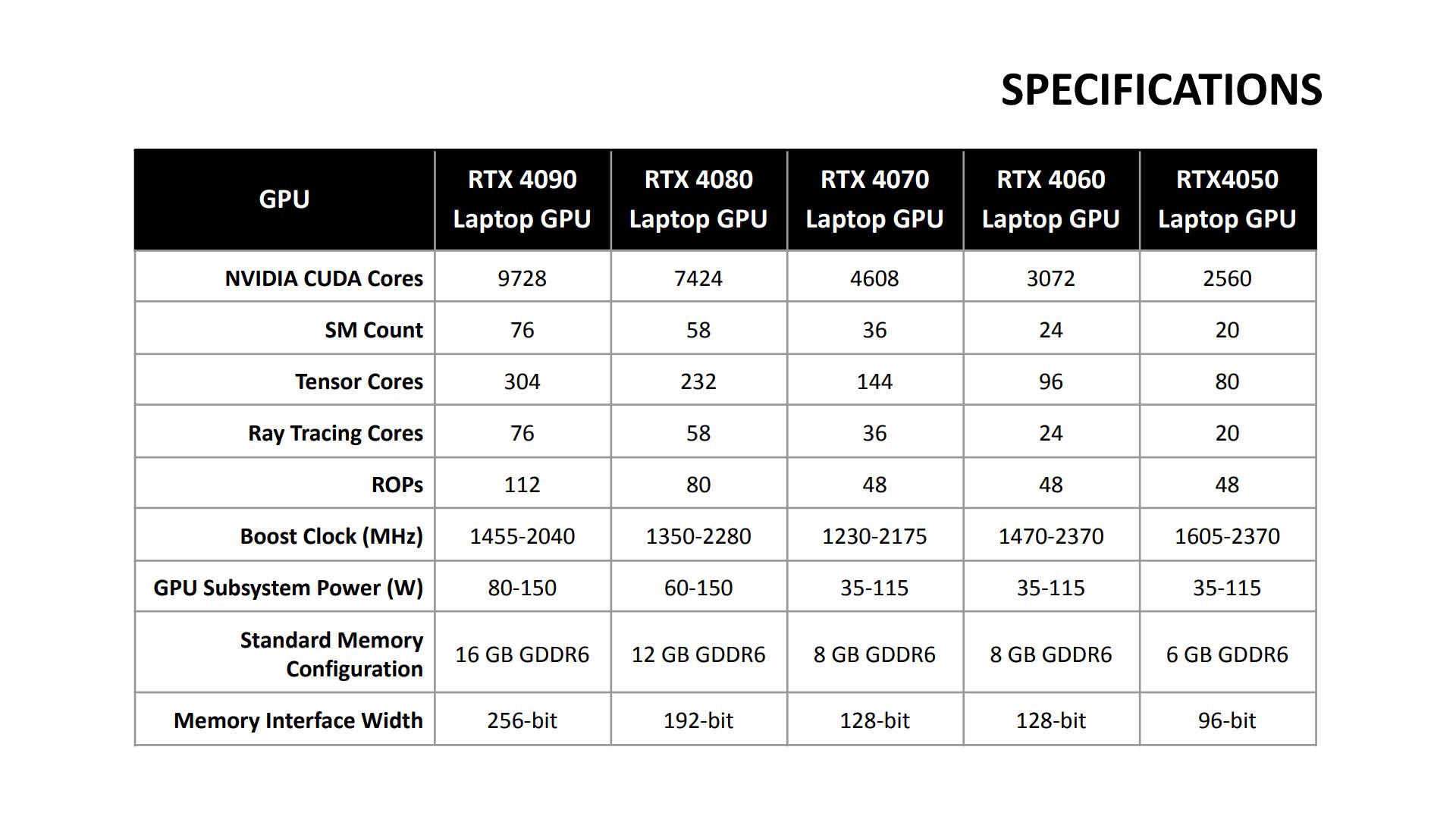
The display
But then there's this glorious, slightly flawed screen. Yes, I love the panel, but it's not without issue. Chiefly is the much-vaunted and hotly anticipated dual-mode design. This is the first UHD+ native screen that can also effectively be a native FHD+ one, too.
How is that possible? Well, at its most basic the panel combines four pixels as one to make up the secondary mode, which ought to give a clearer picture than simple interpolation of a higher res panel. It does, but only slightly. And not in a way that would have me convinced that I was looking at a genuinely native 1920 x 1200 display.
It's also super clunky in that you have to either delve into the BIOS or the mysteries of Razer's Synapse software to enable either mode, and switching requires a full reboot. Actually, scratch that, don't use the BIOS because that way lies confusion. The first time I tried to switch to the lower-res display mode I used the BIOS method (getting into that was a trial unto itself—which required plugging in a USB keyboard to actually get the machine to register my intention to go into its BIOS). That would have been fine if it wasn't for the fact that, when I wished to switch back via the BIOS, the option to do so had mysteriously vanished.
I thought my classic technology bricking aura had boned the world's first multi-screen and was frankly a little vexed. Thankfully Synapse doesn't lose sight of the different modes.

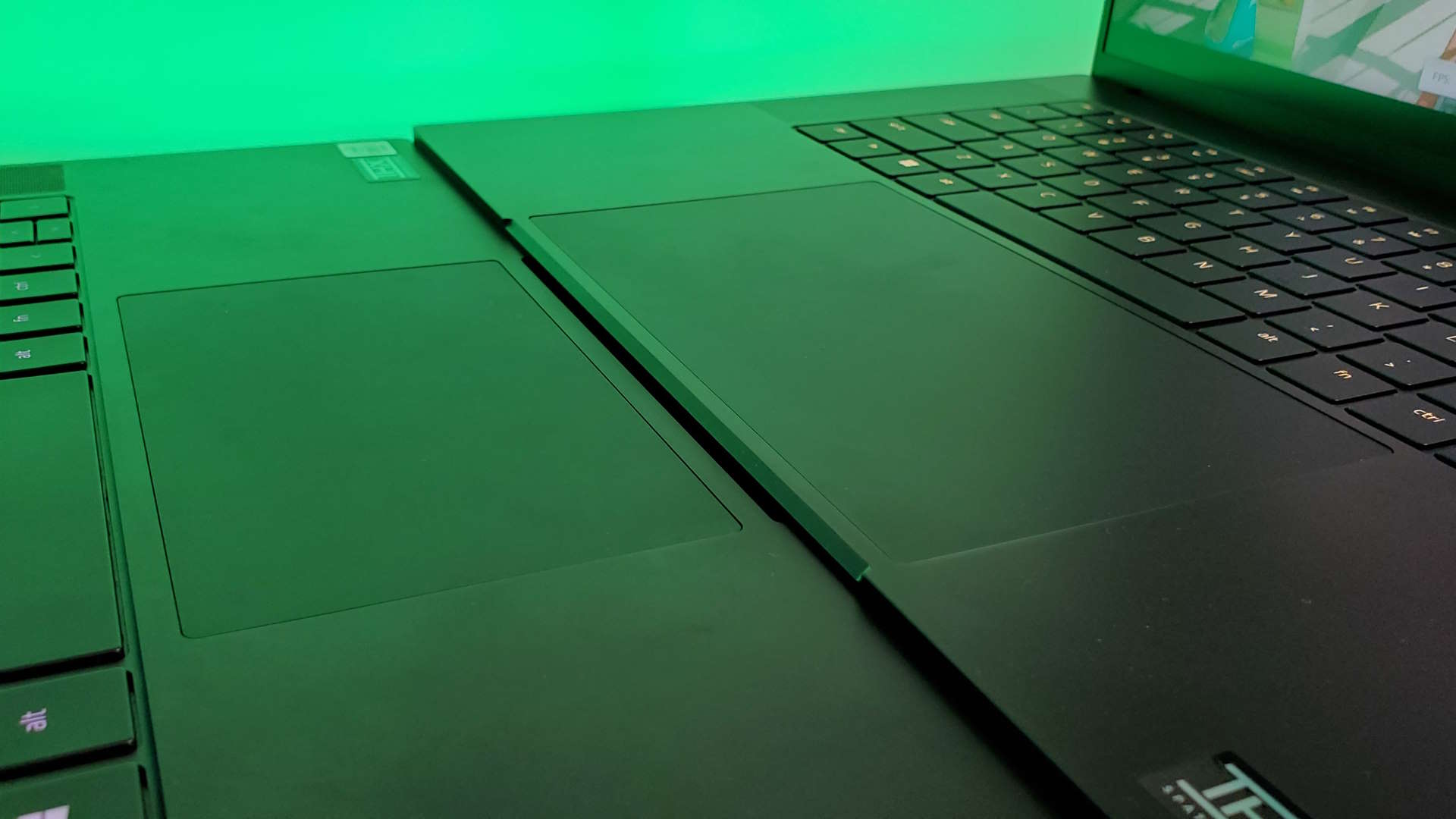
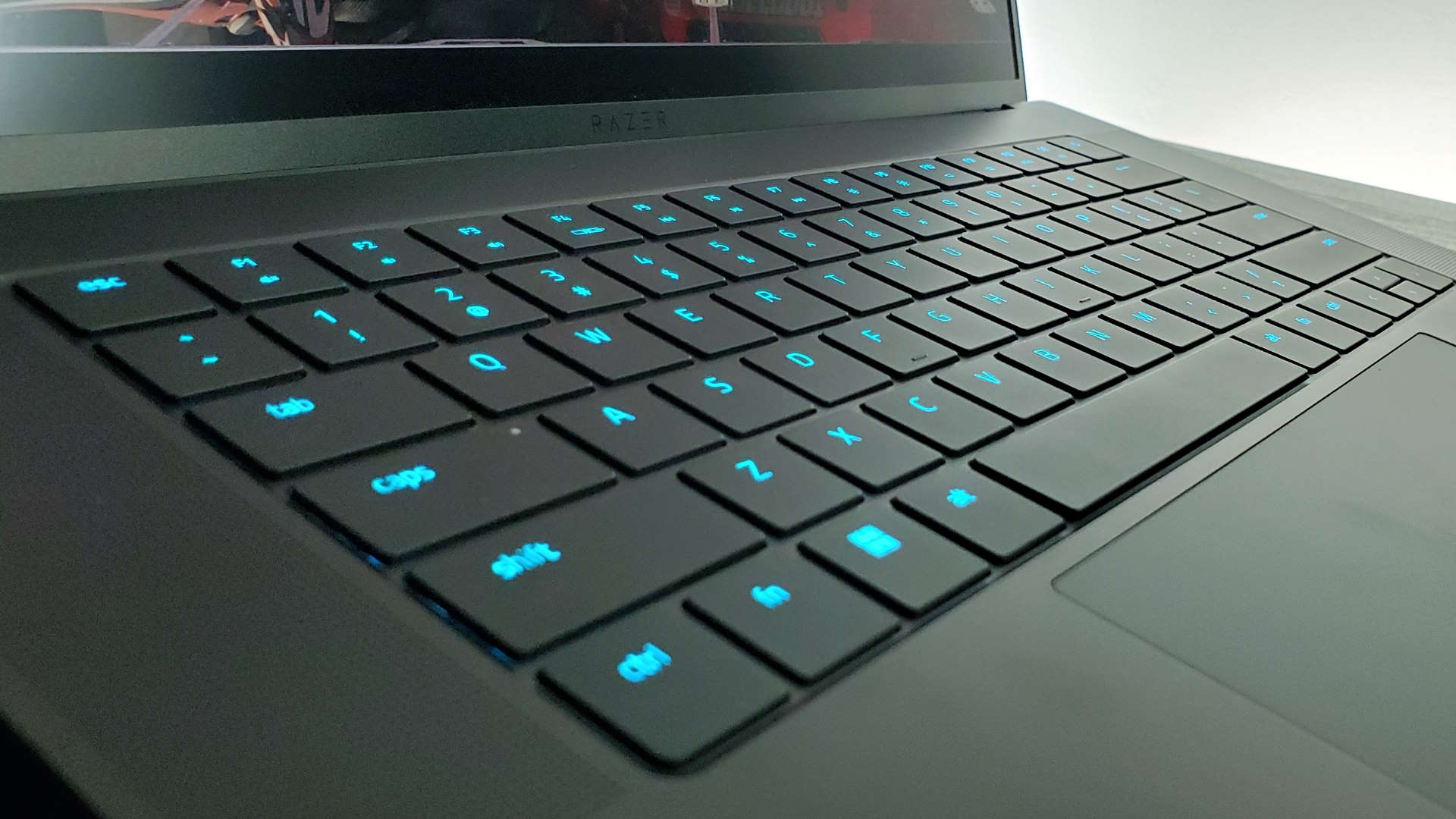

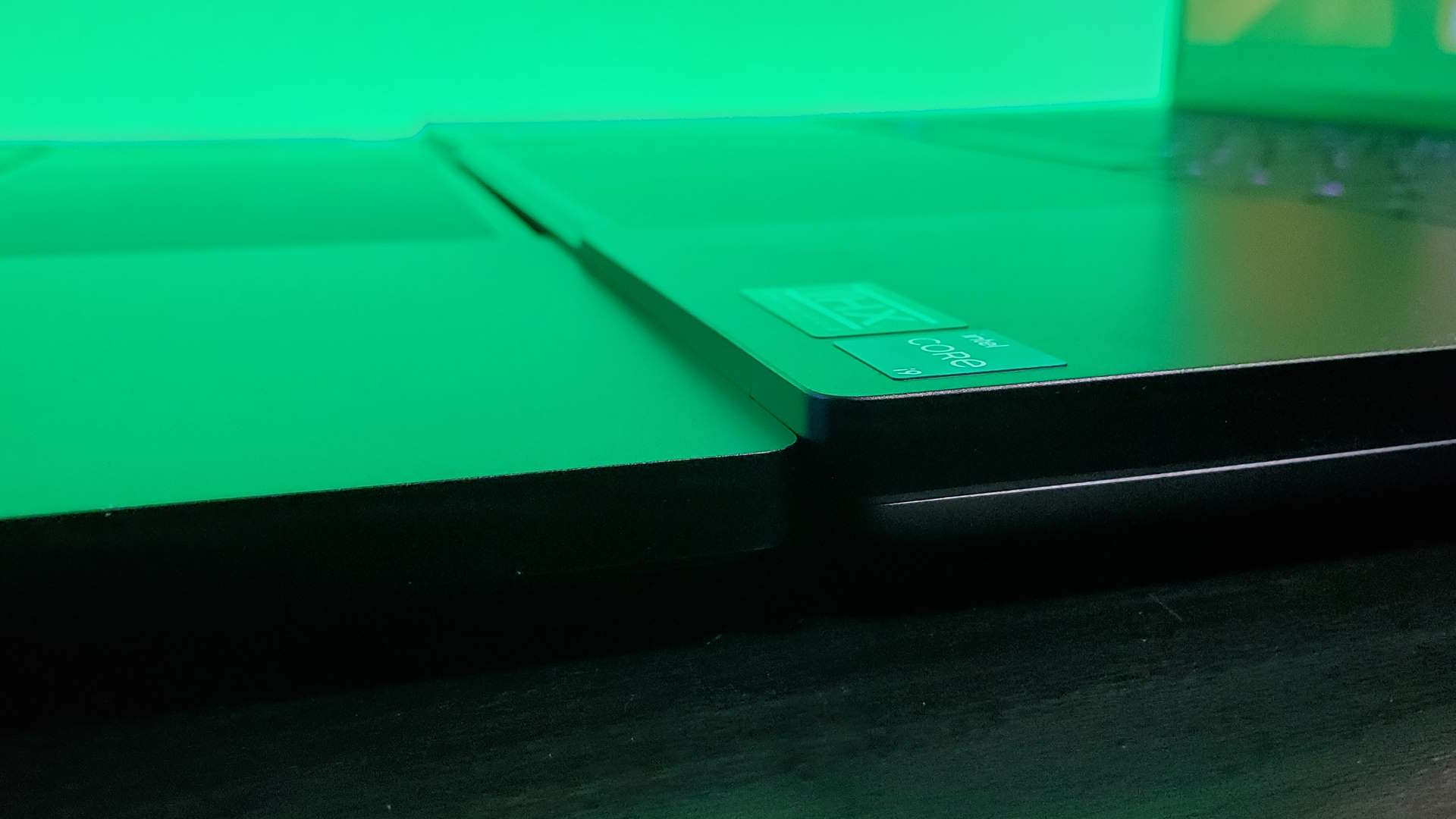
I can happily leave this panel running in HDR mode without it trashing the look of any SDR content.
So, why would you want such a feature? Well, I mean, therein lies the rub. If I'm forced into rebooting to do so I honestly cannot see anyone using it. If it was merely a case of running a lovely UHD+ desktop at 120Hz, and then if I want the higher 240Hz refresh the display dynamically switches to give me the option for its alt-1200p mode, it would then be a neat option for competitive gamers.
As it is you've got to do a whole lot of manual work to get to where you might want to use the feature in a game.
If it genuinely looked like a native 1920 x 1200 panel then I'd be more forgiving, but there's also an obvious aliasing and extra fuzziness compared with the pin-sharp native 360Hz 1080p panel on the Blade 15 I'm testing this next-gen laptop against.
Which is a huge shame, because that detracts from just how great a laptop screen this 16-inch 3840 x 2400 Mini LED display actually is in its true native mode. It is just stunningly good. The 120Hz refresh makes it feel slick, the extra height from the 16:10 aspect ratio really adds to the sense of space the thin bezels and 16-inch of screen real estate deliver, and it's super bright.
It's able to hit 1,000cd/m² in terms of peak luminance and that Mini LED backlight makes all the colours really pop on this panel. I spent a while delving around in The Witcher 3 again, with all the new pretties enabled, and it looks great on this screen. Quite aside from how well it plays in terms of frame rates, it's the detail the UHD+ res affords combined with just how vibrant those colours look that makes it such an attention grabbing display.
And that's only enhanced by how it looks in HDR mode. I don't know why it works this way, but I've looked at a bunch of Mini LED gaming monitors now and they all seem to have glaring local dimming issues, which are most prevalent on the desktop, but it's barely noticeable on the Mini LED laptops I've tested. I can also happily leave this panel running in HDR mode without it trashing the look of any SDR content, or even making the Windows desktop look an absolute state.
I can just leave it on and not think about it until I boot a game which utilises a high dynamic range, and pumps up the vibrancy another notch or three. That's how I want PC HDR to be, and this screen nails it.
Razer Blade 16 benchmarks

In raw performance terms this top-end mobile configuration is outstanding. The frame rates we've seen out of the mobile RTX 4090 are on par with, or even slightly ahead of a desktop RTX 3090 graphics card. And that was the absolute flagship Nvidia GPU when it first launched in 2020.
And it was a massive graphics card with a huge cooler, though admittedly not quite as big as the desktop RTX 4080 this mobile chip is based on. The fact it's running a full 1GHz slower in this slim Razer chassis does mean you're not going to match the desktop GPU for frame rates, but it's still comfortably faster than anything we've seen on the laptop side before.
1080p gaming performance


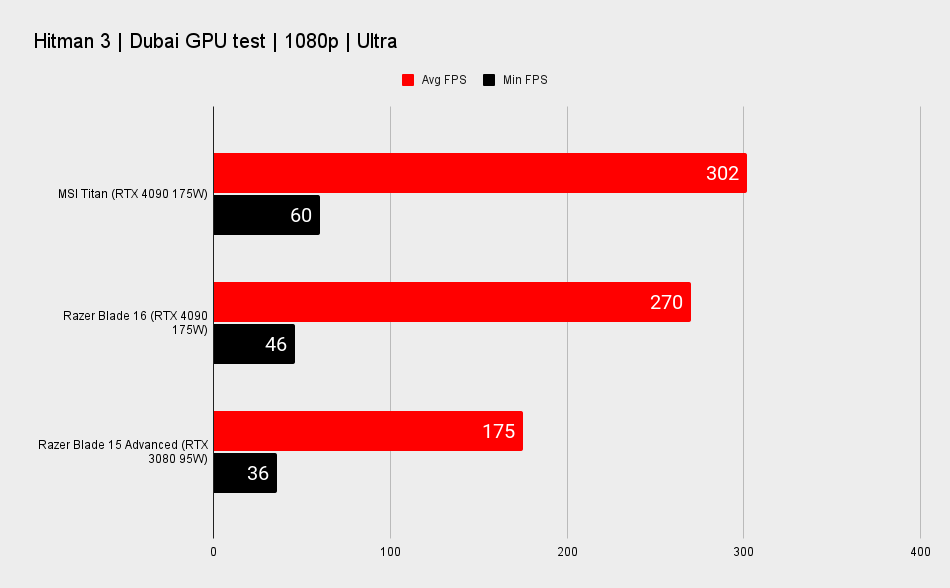
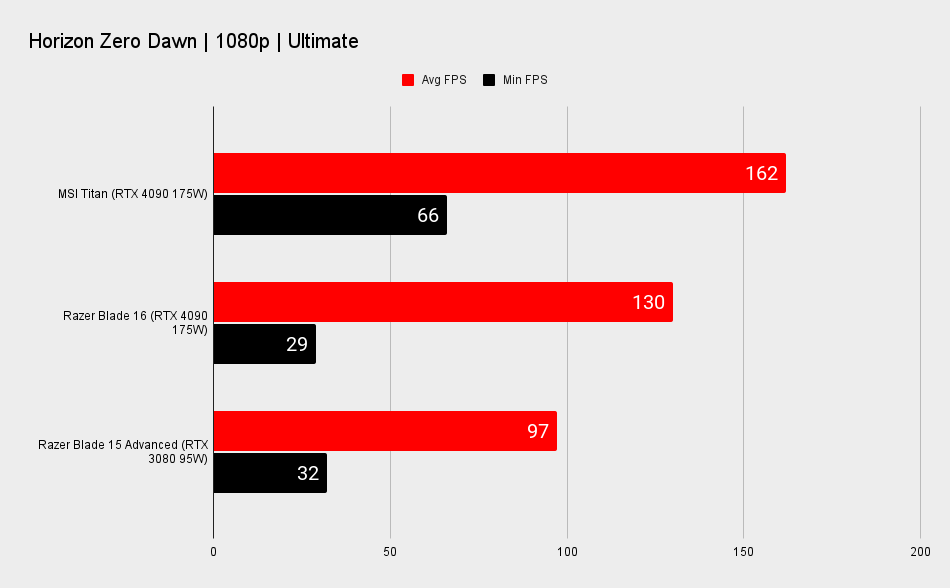

But it's interesting just what difference the chassis can make. Both this Blade 16 and the MSI Titan GT77 use the same 175W configuration of the mobile RTX 4090, yet the massive MSI laptop pulls ahead in practically every benchmark. The larger laptop design and the more aggressive cooling array (seriously, the Titan gets super loud) means the GPU is running over 200MHz quicker on average in the MSI machine.
As with the desktop cards in the new RTX 40-series, however, it's clear that gaming at 1080p is not its forté. The card simply gets too bottlenecked by the processor in too many games for it to be an effective option at this resolution, and this is a top CPU, too. You're not always going to suddenly bag stellar frame rates just because you've dropped down the resolution ladder a couple rungs.
Which is just as well it's paired with such an outstanding UHD+ panel, because that's what will make the GPU sing.
1440p gaming performance
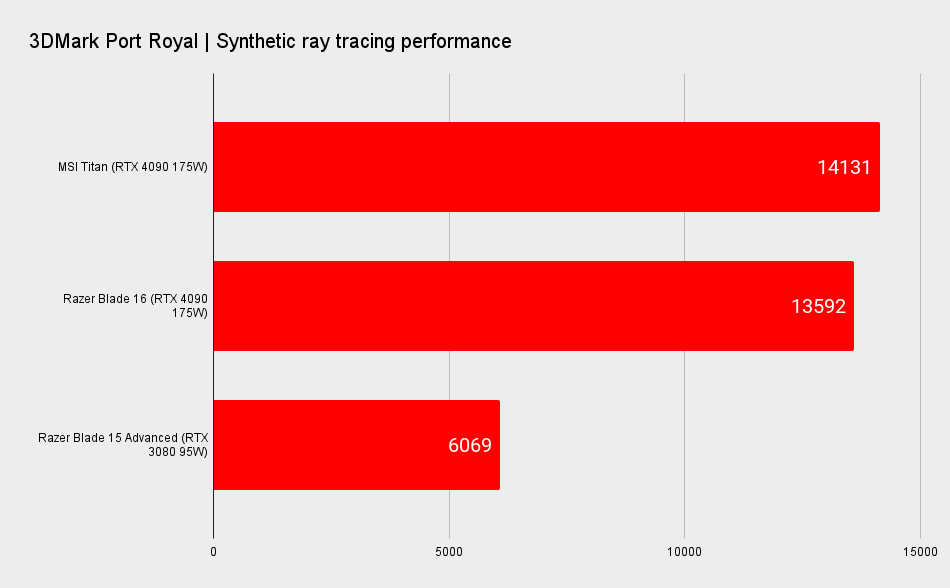
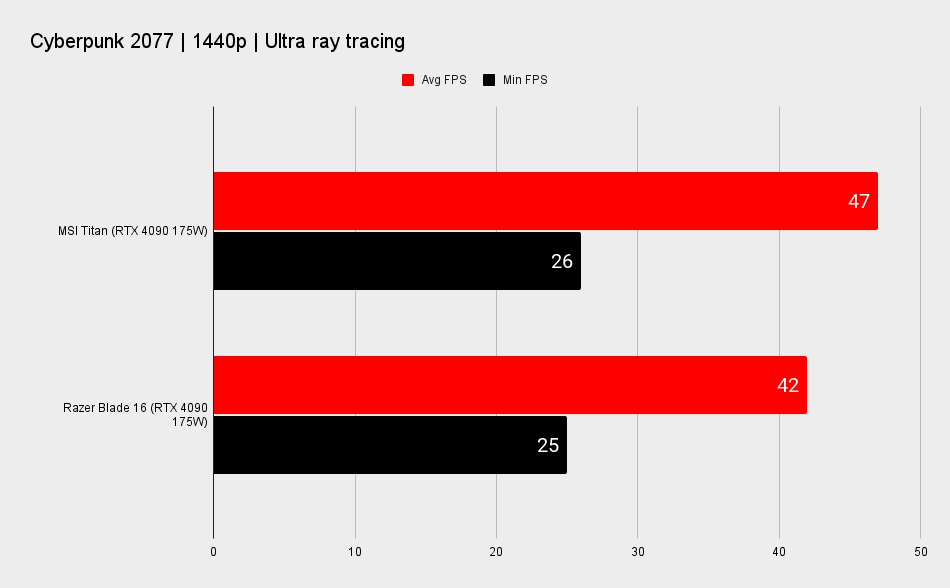

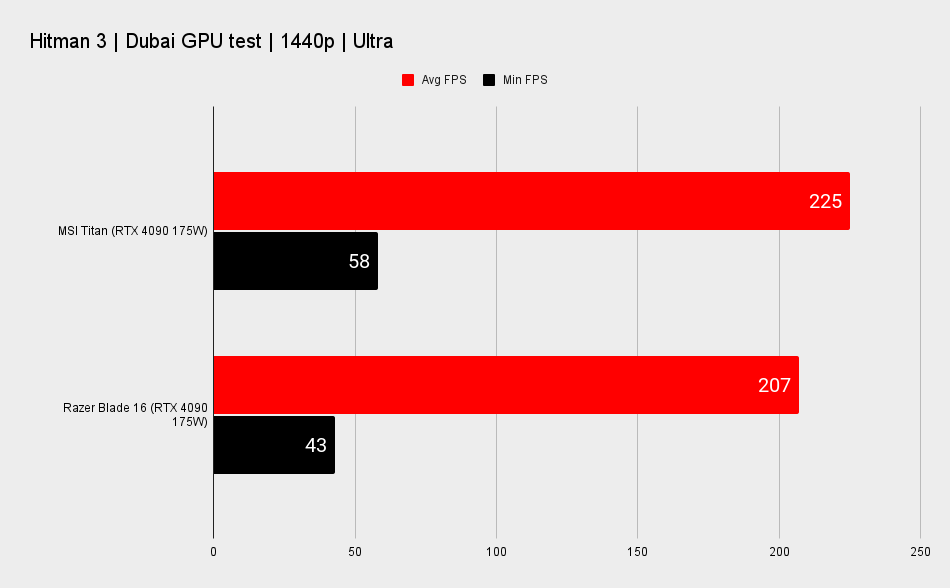
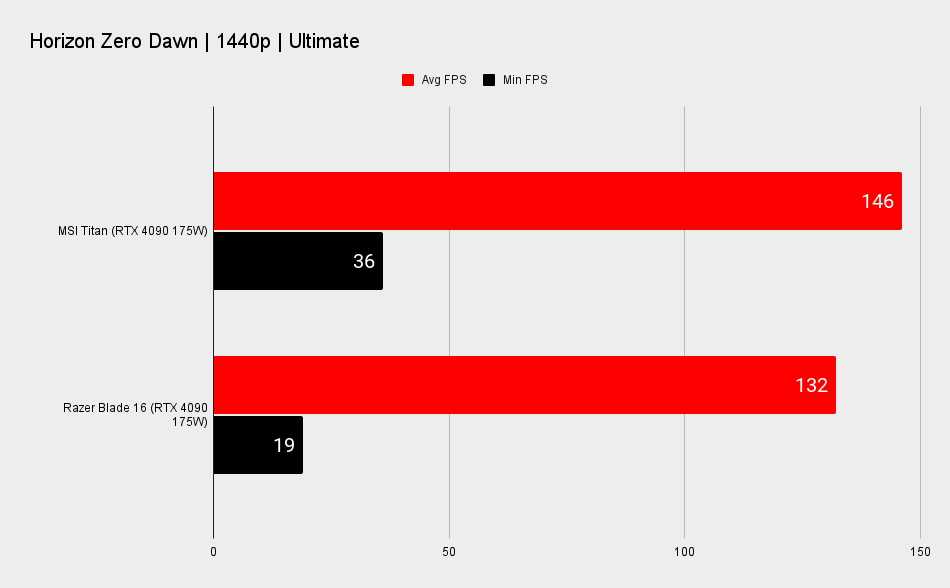
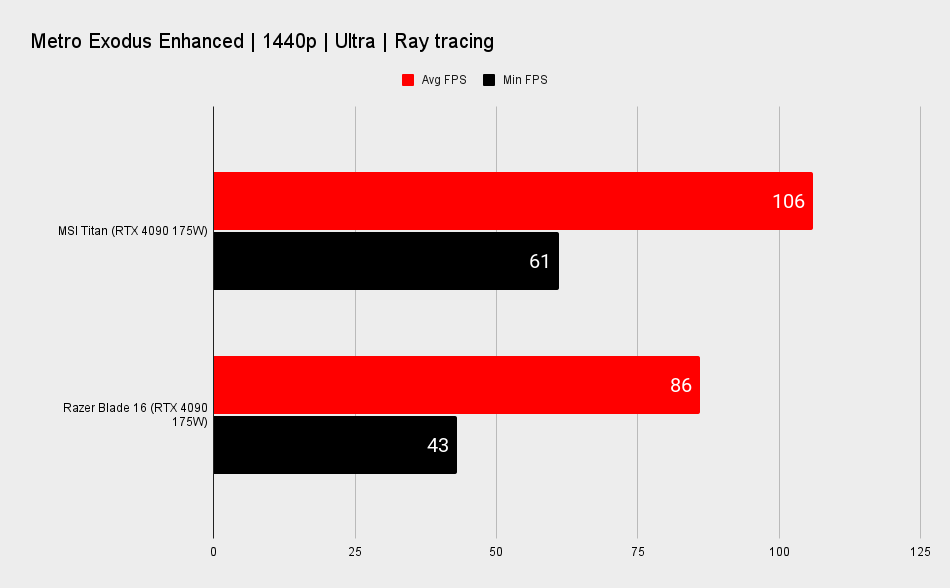
4K gaming performance
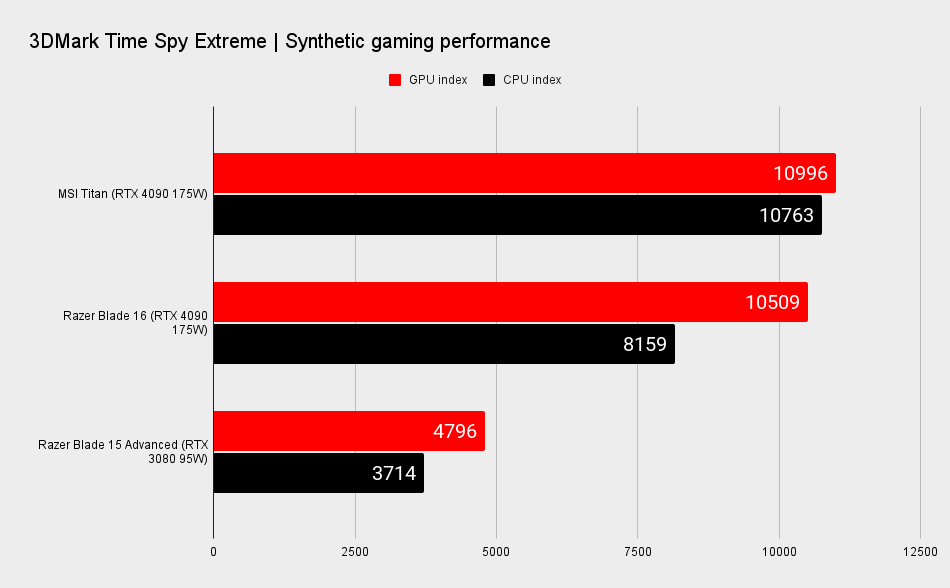



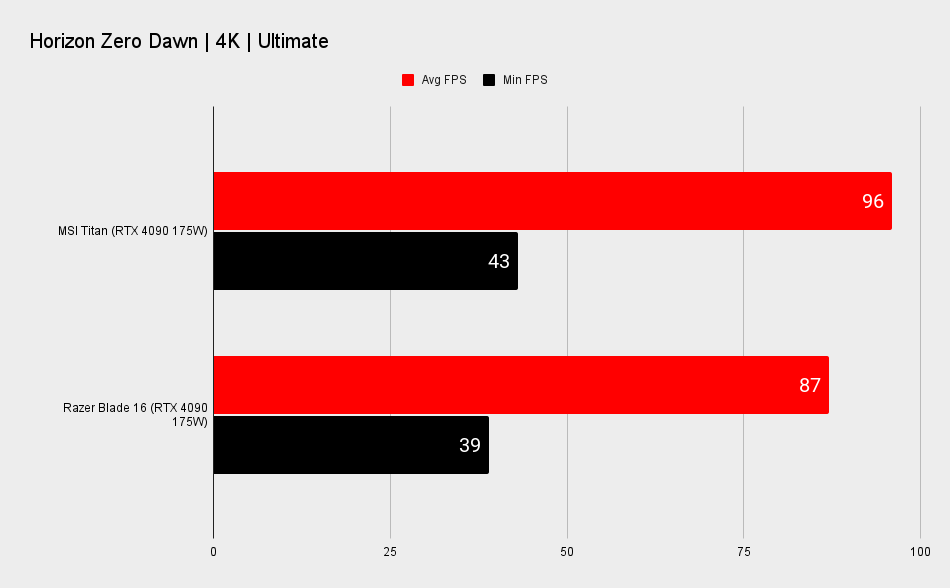
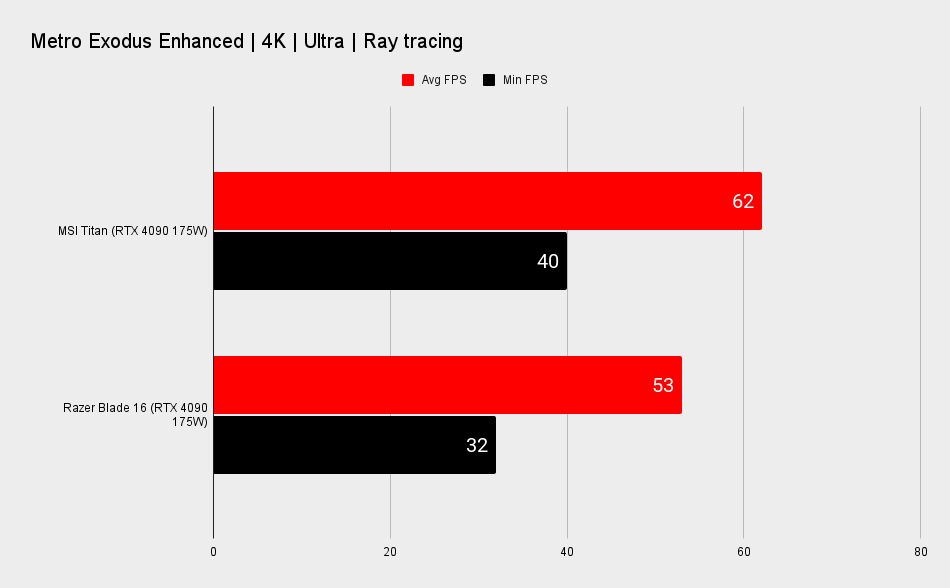
DLSS performance

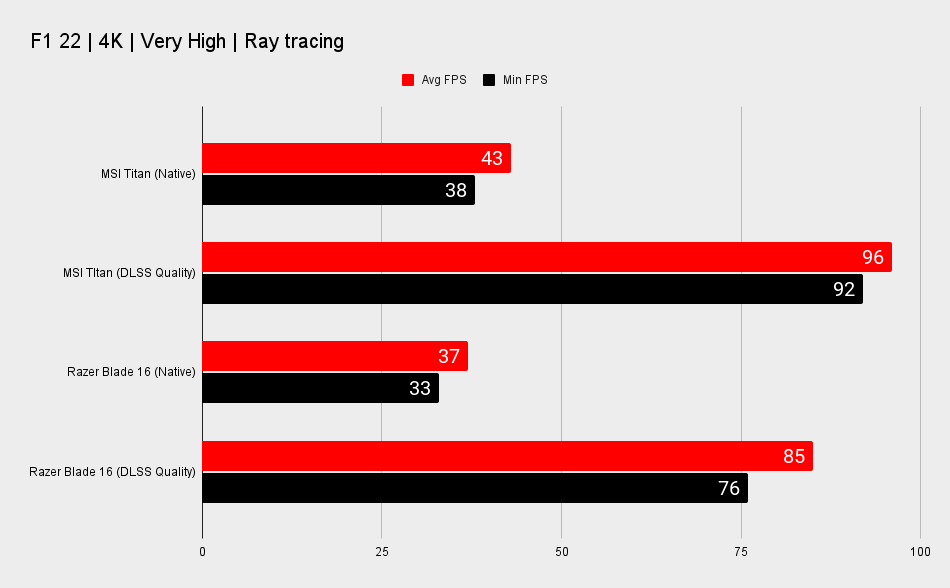

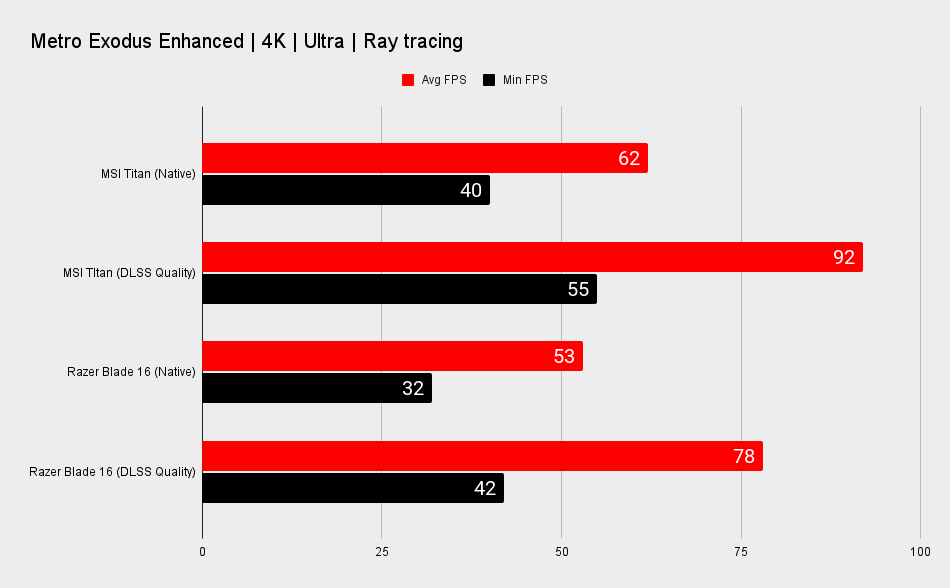
The native performance of the RTX 4090 is seriously impressive, but when you get the DLSS 3 and Frame Generation funtimes rolling the difference is stark. For one, it's the only way to get either Cyberpunk 2077 or The Witcher 3 running at max ray tracing settings, but you're also getting a stellar performance uplift in games without ray tracing, too.
And this is using the peak 'Quality' DLSS setting, where at 4K the input resolution is still high enough that you can actually get away with picking either the 'Balanced' or 'Performance' modes and it still looks pin sharp.
System performance
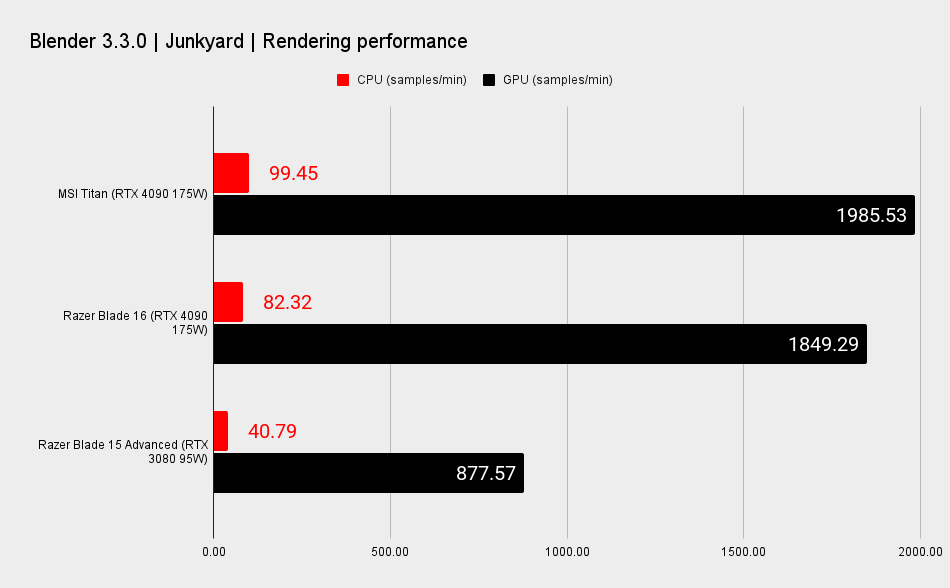
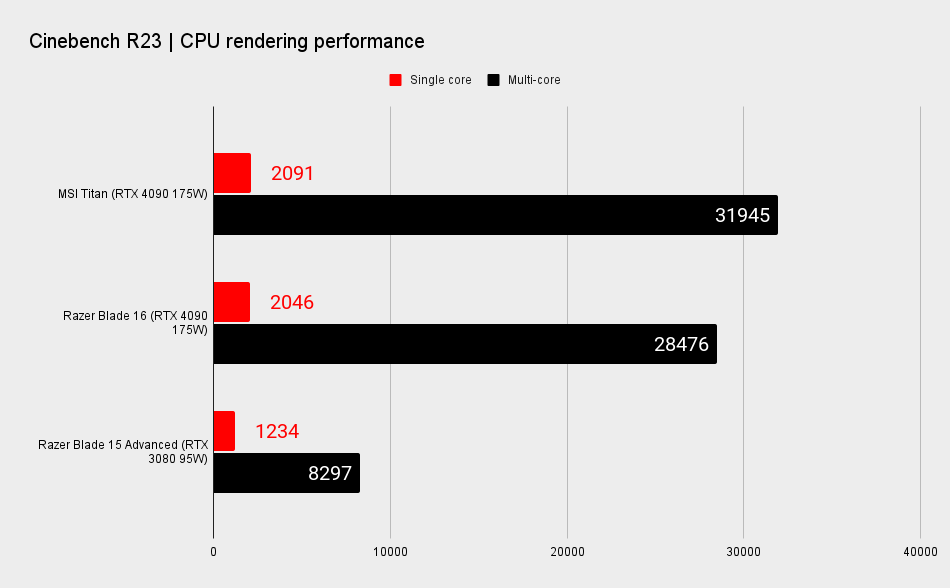

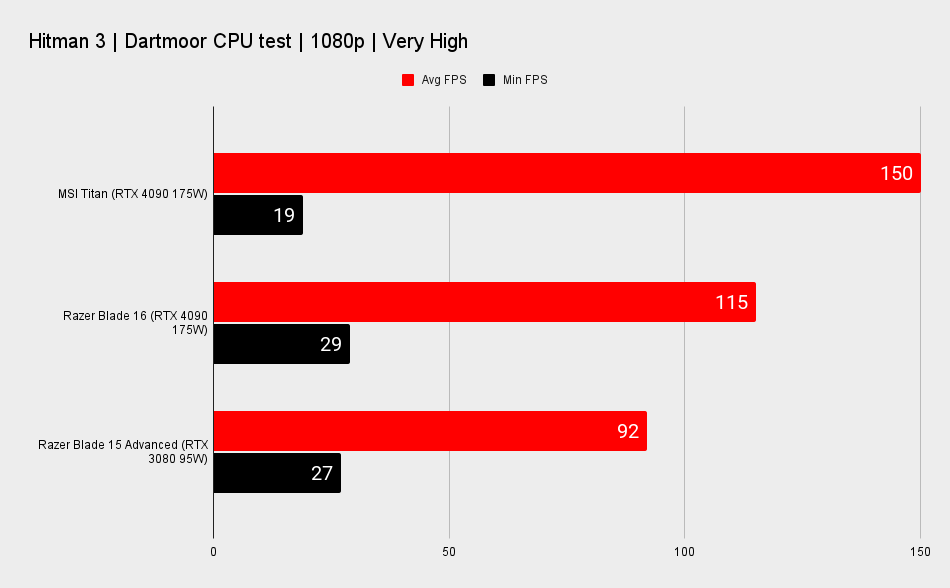
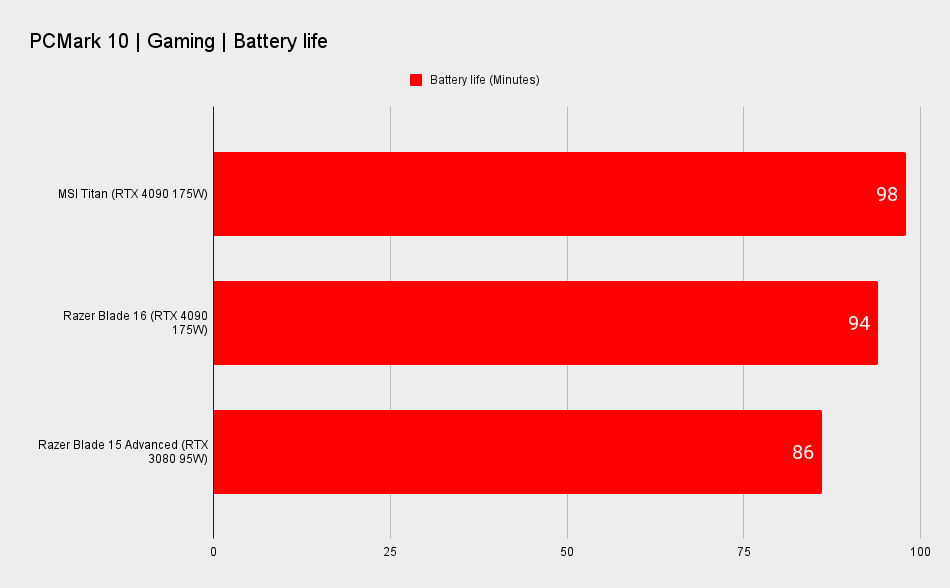
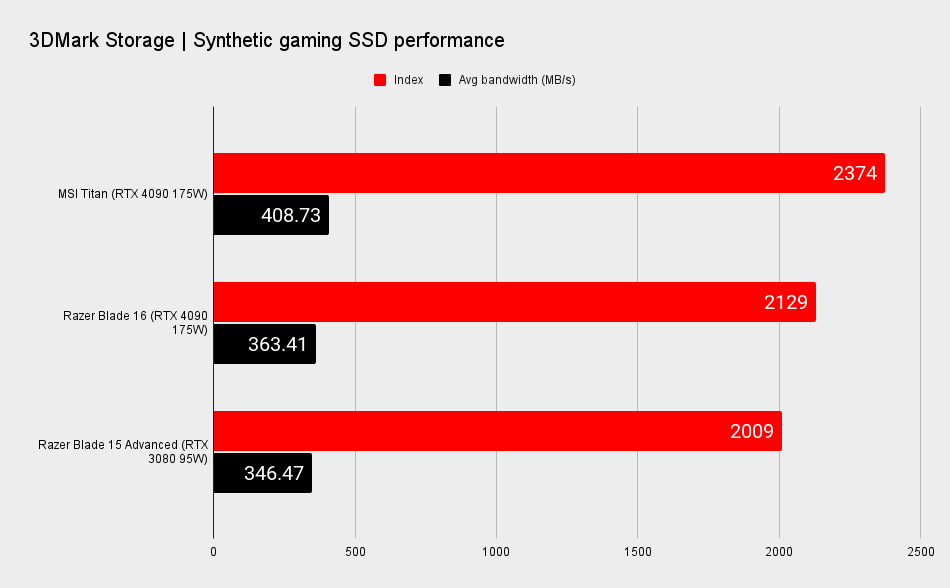


Even though the chassis' cooling holds the hardware back compared with the insanely loud MSI Titan, you are still getting workstation-class performance. The 24-core Intel processor is a gem and posts higher productivity numbers than either the Zen 4 AMD Ryzen 9 7900X and the Alder Lake Core i9 12900K—both serious desktop processors. Then you look at the Blender results and the RTX 4090 again shows it can bury the desktop RTX 3090 in rendering tasks, too.
But yeah, the Blade 16 does get hot, and loud. I've seen the CPU temps go off the chart (literally in this case) where it's bouncing off the 100°C limits and throttling back. It's not so bad on the GPU side, where it runs at an 82°C max. And in games I was measuring an average temp with the RTX 4090 sitting around the 74°C mark.
Razer Blade 16 analysis
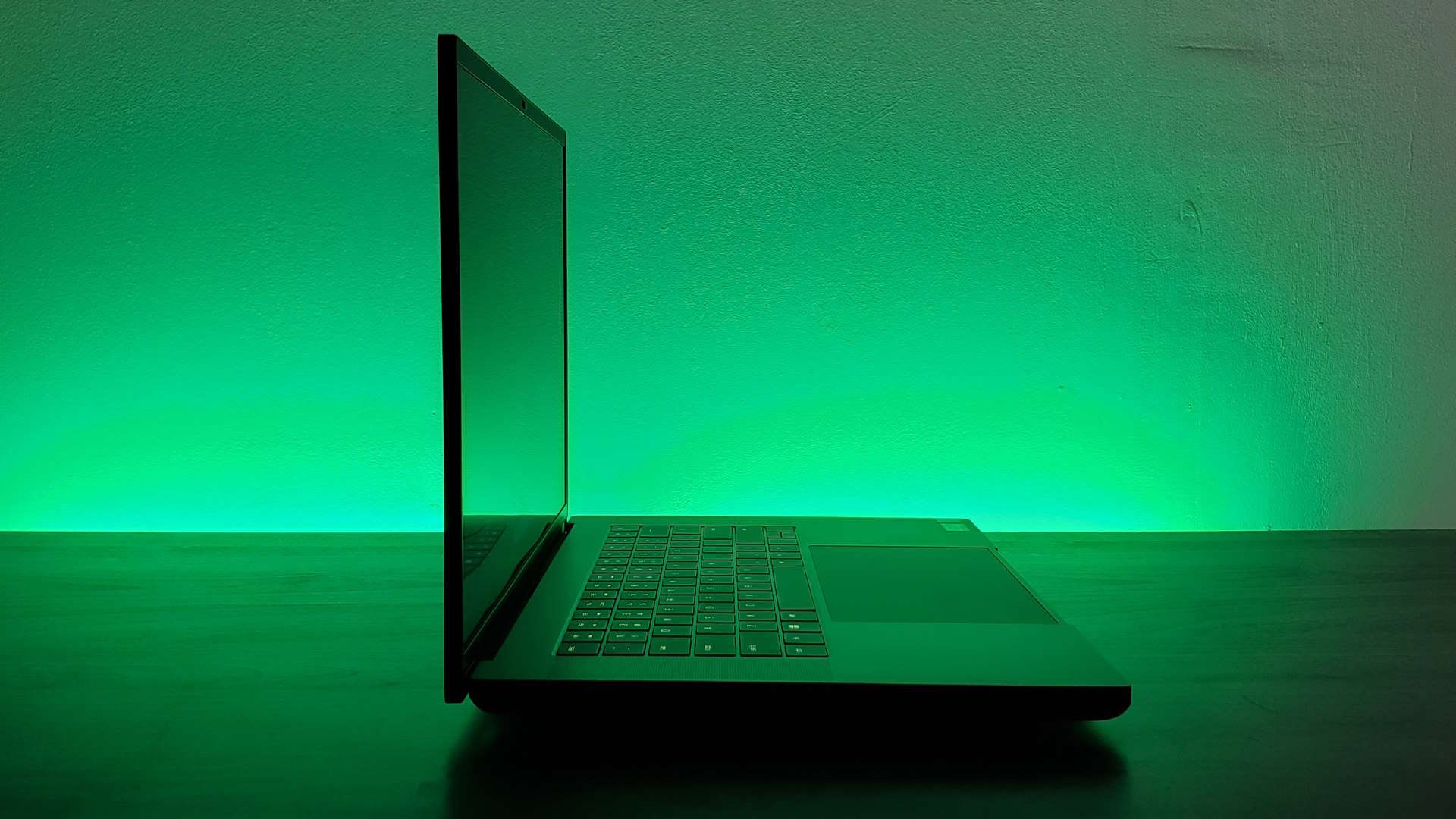
An uber-powerful gaming laptop is not a value proposition, but I still don't want to feel like someone's taking the piss.
I am torn over this machine. The style still really works for me, even if it is most definitely thicker than its Blade 15 predecessor. I love the Blade's unashamed dark side MacBook aesthetic, and I will also admit to being very into that absolutely huge trackpad. Aside from the actual feeling of depressing the trackpad's 'buttons' that is—it just feels a little too spongy for my tastes. I want something with more of a defined click.
It's not the most wonderful typing experience either. I have no issue with the chiclet keys, it's just I feel like that extra chassis height feels noticeable in how much extra pressure it seems to put on the underside of my wrists as I'm typing this review. Those sharp edges create a clean look but I also really feel them digging into my soft man-flesh.
But the overall performance, either when gaming or doing something more serious with your $4,000+ toy, is truly impressive. Sadly that price tag overshadows the serious generational performance leap on offer here.
There just isn't any part of me that feels like I'd be able to get over that initial outlay, and get to a point I felt I'd actually got value for money. I know that an uber-powerful gaming laptop is not a value proposition in the normal sense of it, but I still don't want to feel like someone's taking the piss. And even though that screen would be worth the best part of a grand as a standalone monitor, and the GPU comes from a nominally $1,200 card, that still leaves me with a further two grand to justify the rest of the spec, and that's not working out in my head.
And there are parts of the experience which don't feel as premium as the price suggests. Though that's arguably more about Intel, Microsoft, and Nvidia than Razer. The switching between integrated graphics and discrete GPU feels janky as all hell. With dynamic switching in play thanks to the Optimus tech, Windows can flick between discrete and integrated graphics silicon at will… all it takes is some blank screen intervals, some annoying resizing of windows, and the occasional time where something resets your resolution scaling settings. My eyes are just not good enough to cope with 100% scaling on a 16-inch UHD+ panel.
And this happens every time it switches. And every time it feels like something's going to break.

Jacob will also want me to mention his own personal bugbear; the way the power connector doesn't sit flush with the chassis. It's been the same in previous Blades, and I get why it annoys him. But I'm willing to give Razer a pass here as it does make it easier to get purchase on the plug when detaching it.
But then there's the noise. If you want to hit the benchmark figures posted above you need to run the Blade 16 in a custom balls-to-the-wall power mode, which really spins up those fans. Even if you're just browsing the desktop. Honestly, I don't think I'd ever put it in that mode again while gaming, I just felt a bit embarrassed for it considering the noise it was making.
That custom mode holds the promise of CPU overclocking in the future, however, and should in turn allow for undervolting of the chip. That could make a massive difference for the noise levels, and I'm looking forward to testing that in the future.
The balanced mode, however, still allows you to still hit some impressive frame rates, but holds back the CPU to stop things going absolutely jet-turbine loud. Then there's silent mode which goes further still, hobbling the CPU to the point where when you're gaming it really does negate a consistent gaming experience. But it's certainly been a more merciful mode while I've been typing away in the dead of night, else I might have woken the entire household.
There's a simple key combo to switch between the power modes, and it is instant, which allays some of my concerns about whether I could really use this laptop on a day-to-day basis. Balanced for gaming and silent for everything else, and stay the hell away from monster mode for the sake of your ears and sanity.
Pretty simple really.
Razer Blade 16 verdict
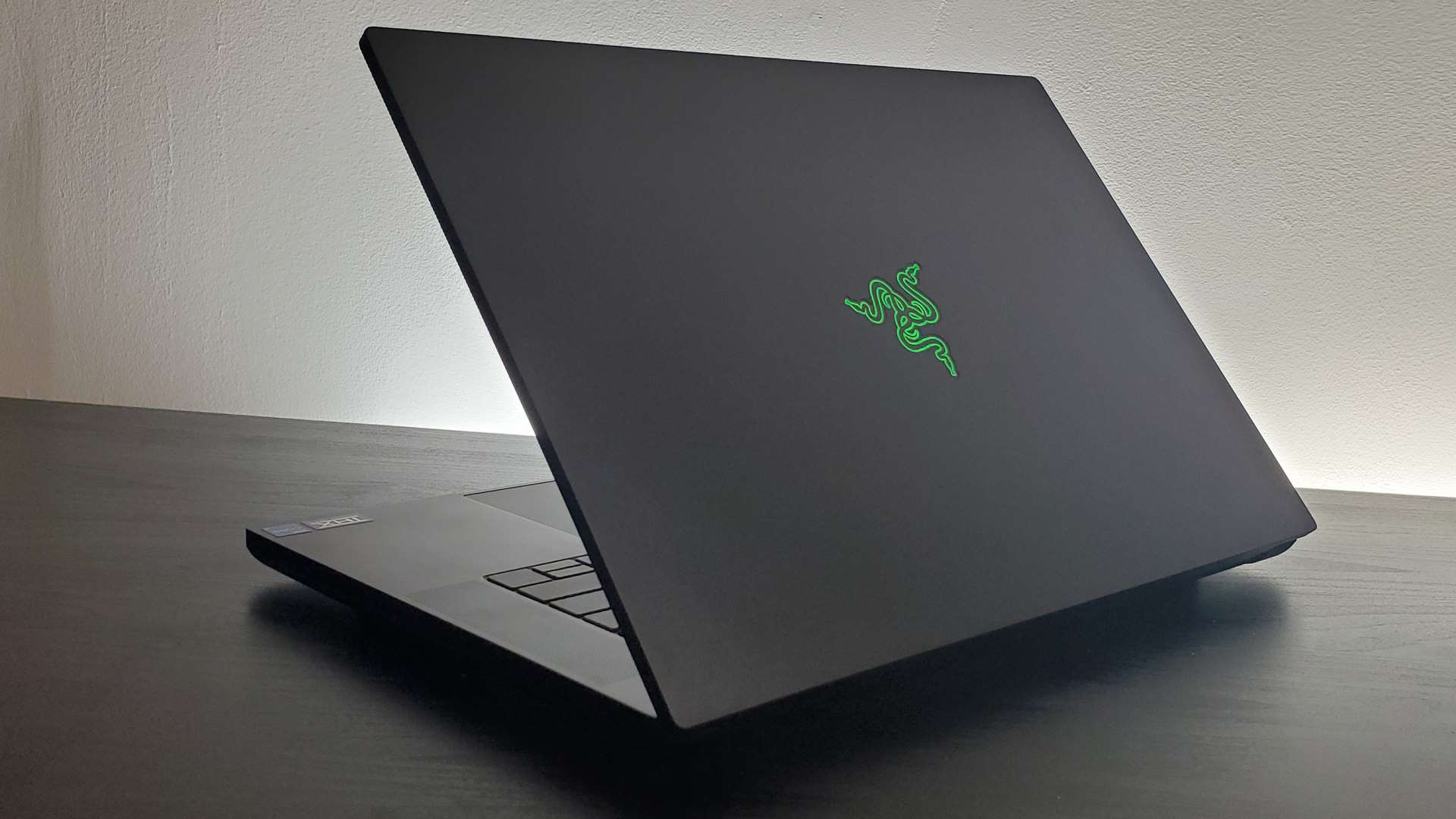
My bank account is empty and my kids are asking why daddy's dancing for pennies behind the Roman Baths.
I think the RTX 4090 / Core i9 13950HX combo is too much for this machine. And I feel like I've said that for every Blade I've tested with the very highest spec hardware inside it. You can find GPU alternatives in the Blade 16 lineup, but sadly that CPU is the only choice you have. Which is a problem for me considering that's what really gets the fans spinning.
So maybe this isn't the Blade 16 for me. But, looking down the stack, I'm concerned about the potential performance of the RTX 4060, especially at nigh-on three grand. So the RTX 4070 version, dead-on $3,000 stands out. The dual-mode screen is dropped in favour of a resolutely single-mode 16:10 QHD+ panel at 240Hz. It's not Mini LED though, so maybe I do want the $3,300 version with the same RTX 4070 GPU but with this stunning panel. Can it drive 4K happily? I don't know, so should I get the RTX 4080 setup? But if I'm already spending that much, what's another couple hundred clams for the top-spec option?
And on up the range until my bank account is empty and my kids are asking why daddy's dancing for pennies behind the Roman Baths again.
As much as I do rate this machine—and I do have a lot of love for large parts of it—I couldn't recommend this version. And until I've tested the lower spec configs, I'm not sure I'd recommend those either. The lack of CPU alternatives, the uncertainty about the performance of mainstream mobile Ada chips, and the super high price tag makes me honestly feel rather hesitant about the vanguard of this new generation of gaming laptops.
This top Blade 16 spec delivers outstanding performance, in both gaming and productivity terms, and retains the classic Blade styling. It also comes with the best laptop screen I've ever used. But inconsistencies in the experience, and a punitive price tag makes it difficult to recommend.

Dave has been gaming since the days of Zaxxon and Lady Bug on the Colecovision, and code books for the Commodore Vic 20 (Death Race 2000!). He built his first gaming PC at the tender age of 16, and finally finished bug-fixing the Cyrix-based system around a year later. When he dropped it out of the window. He first started writing for Official PlayStation Magazine and Xbox World many decades ago, then moved onto PC Format full-time, then PC Gamer, TechRadar, and T3 among others. Now he's back, writing about the nightmarish graphics card market, CPUs with more cores than sense, gaming laptops hotter than the sun, and SSDs more capacious than a Cybertruck.
